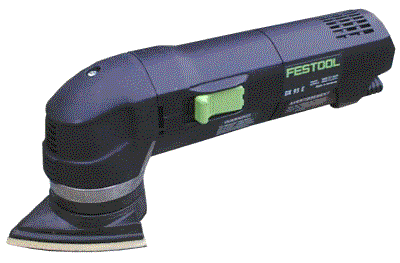|
|
|
| Description The Festool DX93e is a gear driven, variable speed sander with a triangular shaped sanding pad. It has a long slender body, about 12" stem to stern. Dust collection is so well integrated into the tool that unless you see the exhaust port, it doesn't even look like is has this feature. The DX93 uses a true orbital motion instead of an oscillating one. The orbit is actually small at 2.5mm but the action is more aggressive than this would indicate which is good for the intended use of this tool since it is designed for refinishing work. |
 |
| The Deltex comes in a standard Systainer along with an elongated pad for reaching into height constrained places such as when sanding shutters or perhaps chairs. Along with the extension pad, Festool also offers both a hard and soft pad that will fit onto the machine. The Deltex is a sander, it is not a multi tool which in this case means it is the master of one trade as opposed to a practiser of all. Unlike some other Festool products, the Deltex does not use the Plug-it removable cord. | |
 |
In Use As mentioned before, the sanding action is more aggressive than one might think. This is actually good if you are trying to sand off layers of finish. What this seemed to equate to when I used it was that I could use one or two grits higher that what I would have originally thought. The 2 3/8" diameter body of the tool is very easy to grip even though there is no formed handle or anything. The machine uses a slider switch instead of a trigger and is locked on until the back end of the switch is depressed. The speed control is located on the tail of the body. Although you can't control the speed from the grip position, I haven't noticed this as being detrimental, I haven't used the variable speed feature very much at all on this sander. |
| The sander excels at
going into tight corners as one would expect. It can also be used elsewhere and
even serves as a general purpose "power hand sander" for rounding over edges and
such. There isn't any sander that will go absolutely all the way into a corner but
this one gets close enough where a single swipe with a chisel would take care of that last
little bit. Due to the sander's length, you may not be able to use it for sanding
small drawer bottoms but otherwise, it will go just about anywhere. Other sanders have a tendency to bounce off the walls when they get close to the edge, some even damage these surfaces a little if you aren't careful. The Deltex is very tame in this regard and very controllable. Like all Festool sanders, the Deltex is pretty much vibration free. The sandpaper is H&L and easy to change, it's also symmetrical so it can be rotated if you were to wear one side out before another. The sanding pads are also easy to change. The sandpaper itself comes in boxes of 50 & 100 and is reasonably priced (see below). |
|
| Real Value In case you haven't noticed ;) , Festool tools are more expensive than some other brands. However, I would like to take this opportunity to point something out about the marketing and design philosophy of Festool. Although this appears in the review of the Deltex, similar points could be made in the other Festool reviews I've written. Take for example the PC444 detail sander (which I have) which costs about $100 less than the Deltex. What does the Deltex offer for that extra cost?
While it is true that the Deltex does not have any profile sanding capability like the PC, I would argue that in reality, the PC isn't truly capable of doing that either. Let's look at sandpaper cost a little more. Of course it really doesn't cost 6 times more to make those PC sheets. They charge this for their proprietary paper because they know they've got you and they evidently have no qualms about taking advantage of this situation. The exorbitant cost of the PC sandpaper is effectively turning a less expensive tool into one that costs too much to use. Due to the cost of sandpaper, the Deltex really does NOT cost more than the PC444, it's actually cheaper. You can do the calculation, you can literally buy the superior tool with the savings from a few boxes of sandpaper. |
| Summary I’ve been dissatisfied with other sanders of this type that I’ve used in the past; they seem to pretend to sand as opposed to actually sanding. They eventually get the job done but with none of the speed, control, or comfort provided by the Deltex. Once again I find myself in the position of discovering just how suboptimal other tools are in comparison to a Festool. If you find yourself doing a lot of refinish or restoration work, selecting the Deltex over similar tools is pretty much a no brainer. Other tools will cost more to operate and more importantly if you are a professional, take longer to accomplish the job. |
In the interest of full disclosure Festool provided this product to facilitate this review.
|